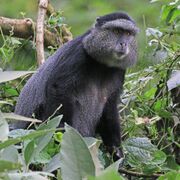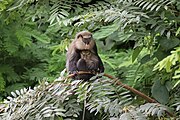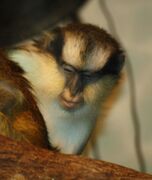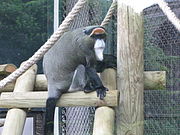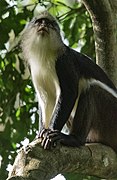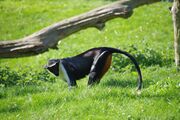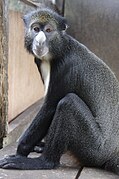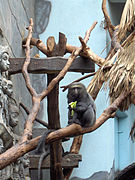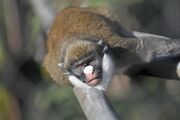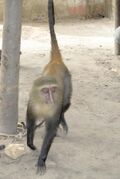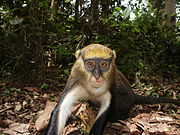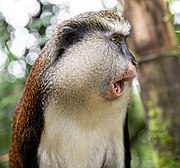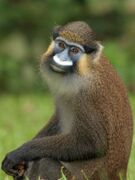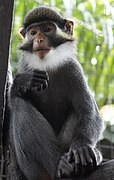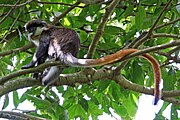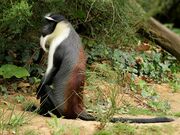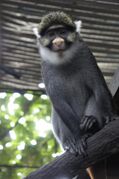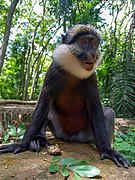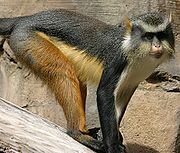Biology:Guenon
| Guenons[1] | |
|---|---|
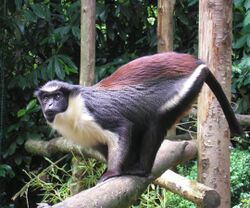
| |
| Diana monkey (C. diana) | |
| Scientific classification | |
| Domain: | Eukaryota |
| Kingdom: | Animalia |
| Phylum: | Chordata |
| Class: | Mammalia |
| Order: | Primates |
| Suborder: | Haplorhini |
| Infraorder: | Simiiformes |
| Family: | Cercopithecidae |
| Subfamily: | Cercopithecinae |
| Tribe: | Cercopithecini |
| Genus: | Cercopithecus Linnaeus, 1758 |
| Type species | |
| Simia diana | |
| Species | |
|
See text | |
All members of the genus are endemic to sub-Saharan Africa, and most are forest monkeys. Many of the species are quite local in their ranges, and some have even more local subspecies. Many are threatened or endangered because of habitat loss. The species currently placed in the genus Chlorocebus, such as vervet monkeys and green monkeys, were formerly considered as a single species in this genus, Cercopithecus aethiops.
In the English language, the word "guenon" is apparently of French origin.[2] In French, guenon was the common name for all species and individuals, both males and females, from the genus Cercopithecus. In all other monkey and apes species, the French word guenon designates only the females.[3] The 3 species such as the L'hoest's monkey, Preuss's monkey and the sun-tailed monkey were formerly included in the genus and now listed in a different genus Allochrocebus[1][4][5]
Classification
The genus Cercopithecus, derived from the Ancient Greek terms κέρκος (kérkos, “tail”) and πίθηκος (píthēkos, "ape"), was named by Carl Linnaeus in 1758.
Species list
| Common name | Scientific name and subspecies | Range | Size and ecology | IUCN status and estimated population |
|---|---|---|---|---|
| Blue monkey | C. mitis Wolf, 1822 Sixteen subspecies
|
Sub-Saharan Africa
|
Size: 31–70 cm (12–28 in) long, plus 55–109 cm (22–43 in) tail[6] Habitat: Forest[7] Diet: Fruit and leaves, as well as invertebrates[8] |
LC
|
| Campbell's mona monkey | C. campbelli Waterhouse, 1838 |
Western Africa
|
Size: 36–55 cm (14–22 in) long, plus 49–85 cm (19–33 in) tail[9] Habitat: Forest, savanna, and shrubland[10] Diet: Fruit, leaves, seeds and grains, as well as birds, bird eggs, small reptiles, and insects[9] |
NT
|
| Crested mona monkey | C. pogonias Bennett, 1833 Three subspecies
|
Central Africa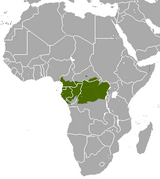
|
Size: 34–55 cm (13–22 in) long, plus 48–87 cm (19–34 in) tail[11] Habitat: Forest[12] Diet: Fruit and seeds, as well as leaves, flowers and insects[12] |
NT
|
| De Brazza's monkey | C. neglectus Schlegel, 1876 |
Central Africa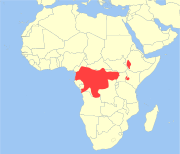
|
Size: 39–60 cm (15–24 in) long, plus 47–79 cm (19–31 in) tail[13] Habitat: Inland wetlands and forest[14] Diet: Fruit, as well as leaves, flowers, mushrooms, beetles, termites, and worms[15] |
LC |
| Dent's mona monkey | C. denti Thomas, 1907 |
Central Africa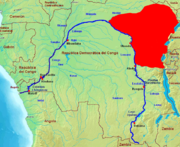
|
Size: 40–70 cm (16–28 in) long, plus 70–90 cm (28–35 in) tail[16] Habitat: Forest[17] Diet: Fruit and arthropods, as well as flowers, caterpillars, shoots, and leaves[17] |
LC
|
| Diana monkey | C. diana (Linnaeus, 1758) |
Western Africa
|
Size: 40–55 cm (16–22 in) long, plus 50–75 cm (20–30 in) tail[18] Habitat: Forest[19] Diet: Fruit, flowers, leaves, insects, and other invertebrates[18] |
EN
|
| Greater spot-nosed monkey | C. nictitans (Linnaeus, 1766) Five subspecies
|
Western Africa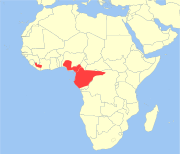
|
Size: 40–57 cm (16–22 in) long, plus 56–100 cm (22–39 in) tail[20] Habitat: Forest[21] Diet: Fruits and seeds, as well as leaves and insects[22] |
NT
|
| Hamlyn's monkey | C. hamlyni Pocock, 1907 Two subspecies
|
Central Africa
|
Size: 43–63 cm (17–25 in) long, plus 49–63 cm (19–25 in) tail[23] Habitat: Forest[24] Diet: Shoots, leaves, plants, and herbs, as well as fruit and seeds[25] |
VU
|
| Lesser spot-nosed monkey | C. petaurista (Schreber, 1774) Two subspecies
|
Western Africa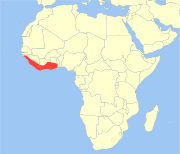
|
Size: 29–53 cm (11–21 in) long, plus 57–78 cm (22–31 in) tail[26] Habitat: Forest[27] Diet: Fruit as well as insects[26] |
NT
|
| Lesula | C. lomamiensis Hart et al., 2012 |
Central Africa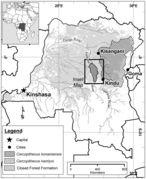
|
Size: 40–65 cm (16–26 in) long, plus 40–65 cm (16–26 in) tail[28] Habitat: Forest[29] Diet: Leaves, fruits and flowers[30] |
VU
|
| Lowe's mona monkey | C. lowei Thomas, 1923 |
Western Africa (in green)
|
Size: 36–55 cm (14–22 in) long, plus 54–85 cm (21–33 in) tail[31] Habitat: Forest and savanna[32] Diet: Fruit and insects[31] |
VU
|
| Mona monkey | C. mona (Schreber, 1774) |
Western Africa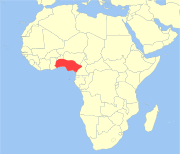
|
Size: 32–53 cm (13–21 in) long, plus 67–90 cm (26–35 in) tail[33] Habitat: Forest[34] Diet: Fruit, sprouts, leaves, and invertebrates[33] |
NT
|
| Moustached guenon | C. cephus (Linnaeus, 1758) Three subspecies
|
Western Africa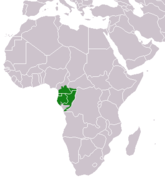
|
Size: 44–60 cm (17–24 in) long, plus 66–99 cm (26–39 in) tail[35] Habitat: Forest[36] Diet: Fruit, as well as seeds, leaves, insects, and eggs[37] |
LC |
| Red-eared guenon | C. erythrotis Waterhouse, 1838 Two subspecies
|
Western Africa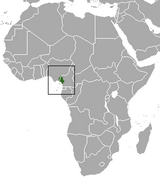
|
Size: 36–55 cm (14–22 in) long, plus 46–77 cm (18–30 in) tail[38] Habitat: Forest[39] Diet: Fruit, as well as leaves, shoots and arthropods[39] |
VU
|
| Red-tailed monkey | C. ascanius (Audebert, 1799) Five subspecies
|
Central Africa
|
Size: 34–55 cm (13–22 in) long, plus 67–92 cm (26–36 in) tail[40] Habitat: Forest[41] Diet: Fruit, as well as leaves, insects, flowers, buds, and tree gum[42] |
LC
|
| Roloway monkey | C. roloway (Schreber, 1774) |
Western Africa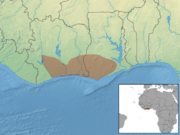
|
Size: 44–62 cm (17–24 in) long, plus 70–91 cm (28–36 in) tail[43] Habitat: Forest[44] Diet: Insects, as well as seeds, fruit, and leaves[43] |
CR
|
| Sclater's guenon | C. sclateri Pocock, 1904 |
Western Africa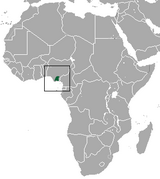
|
Size: 32–38 cm (13–15 in) long, plus 61–85 cm (24–33 in) tail[45] Habitat: Forest[46] Diet: Fruit, as well as insects, flowers and leaves[47] |
EN
|
| White-throated guenon | C. erythrogaster Gray, 1866 Two subspecies
|
Western Africa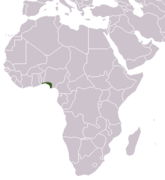
|
Size: 38–46 cm (15–18 in) long, plus 58–70 cm (23–28 in) tail[26] Habitat: Forest and inland wetlands[48] Diet: Fruit[48] |
EN
|
| Wolf's mona monkey | C. wolfi (Meyer, 1891) Three subspecies
|
Central Africa | Size: 44–52 cm (17–20 in) long, plus 69–83 cm (27–33 in) tail[49] Habitat: Forest[50] Diet: Fruit, leaves, seeds, and flowers[49] |
NT
|
Hybrids
The red-tailed monkey (Cercopithecus ascanius) is known to hybridize with the blue monkey (C. mitis) in several locations in the wild in Africa.[51]
References
- ↑ 1.0 1.1 Groves, C. P. (2005). "GENUS Cercopithecus". in Wilson, D. E.; Reeder, D. M. Mammal Species of the World: A Taxonomic and Geographic Reference (3rd ed.). Johns Hopkins University Press. pp. 154-158. ISBN 978-0-8018-8221-0. OCLC 62265494. http://www.departments.bucknell.edu/biology/resources/msw3/browse.asp?id=12100434.
- ↑ guenon /gəˈnoʊn/ n. M19. [Fr., of uncertain origin.] (The New Shorter Oxford English Dictionary, Clarendon Press, Oxford, Vol. 1 A-M, 1993 edition, see page 1,157)
- ↑ guenon [gənɔ̃] n. f. - 1505; o. i.; p.-ê même rad. que guenille 1. vx Cercopithèque, mâle ou femelle. 2. MOD. Singe femelle. [...] (Le Petit Robert, grand format, Dictionnaires Le Robert, Paris, first edition: 1967, Nouveau Petit Robert edition: 1993, grand format edition: 1996, ISBN:2-85036-469-X, see page 1,056)
- ↑ "Allochrocebus". ITIS. https://www.itis.gov/servlet/SingleRpt/SingleRpt.
- ↑ "Allochrocebus". Mammal Diversity Database. https://mammaldiversity.org/#YWxsb2Nocm9jZWJ1cysmZ2xvYmFsX3NlYXJjaD10cnVlJmxvb3NlPXRydWU.
- ↑ Kingdon 2015, p. 175
- ↑ 7.0 7.1 Butynski, T. M.; de Jong, Y. A. (2019). "Cercopithecus mitis". IUCN Red List of Threatened Species 2019: e.T4221A196007901. doi:10.2305/IUCN.UK.2019-3.RLTS.T4221A196007901.en. https://www.iucnredlist.org/species/4221/196007901.
- ↑ Strawder, Nicole (2001). "Cercopithecus mitis". University of Michigan. https://animaldiversity.org/accounts/Cercopithecus_mitis/.
- ↑ 9.0 9.1 Leinberger, Kaitlynn (2022). "Cercopithecus campbelli". University of Michigan. https://animaldiversity.org/accounts/Cercopithecus_campbelli/.
- ↑ 10.0 10.1 Matsuda Goodwin, R.; Gonedelé Bi, S.; Koné, I. (2020). "Cercopithecus campbelli". IUCN Red List of Threatened Species 2020: e.T136930A92374066. doi:10.2305/IUCN.UK.2020-2.RLTS.T136930A92374066.en. https://www.iucnredlist.org/species/136930/92374066.
- ↑ Kingdon 2015, p. 168
- ↑ 12.0 12.1 12.2 Maisels, F.; Cronin, D. T.; Hart, J.; Etiendem, D.; Oates, J. F.; Butynski, T. M.; Linder, J. (2020). "Cercopithecus pogonias". IUCN Red List of Threatened Species 2020: e.T92411527A197301301. doi:10.2305/IUCN.UK.2020-1.RLTS.T92411527A197301301.en. https://www.iucnredlist.org/species/92411527/197301301.
- ↑ Kingdon 2015, p. 161
- ↑ 14.0 14.1 Mwenja, I.; Maisels, F.; Hart, J. A. (2019). "Cercopithecus neglectus". IUCN Red List of Threatened Species 2019: e.T4223A17947167. doi:10.2305/IUCN.UK.2019-3.RLTS.T4223A17947167.en. https://www.iucnredlist.org/species/4223/17947167.
- ↑ Stein, Joshua (2002). "Cercopithecus neglectus". University of Michigan. https://animaldiversity.org/accounts/Cercopithecus_neglectus/.
- ↑ Kingdon 2015, p. 166
- ↑ 17.0 17.1 17.2 Detwiler, K. M.; Hart, J. A.; Hicks, T. C. (2020). "Cercopithecus denti". IUCN Red List of Threatened Species 2020: e.T136885A92413658. doi:10.2305/IUCN.UK.2020-2.RLTS.T136885A92413658.en. https://www.iucnredlist.org/species/136885/92413658.
- ↑ 18.0 18.1 Kennedy, Karen (2023). "Cercopithecus diana". University of Michigan. https://animaldiversity.org/accounts/Cercopithecus_diana/.
- ↑ 19.0 19.1 Koné, I.; McGraw, S.; Gonedelé Bi, S.; Oates, J. F. (2019). "Cercopithecus diana". IUCN Red List of Threatened Species 2019: e.T4245A92384250. doi:10.2305/IUCN.UK.2019-3.RLTS.T4245A92384250.en. https://www.iucnredlist.org/species/4245/92384250.
- ↑ Kingdon 2015, p. 174
- ↑ 21.0 21.1 Cronin, D. T.; Maisels, F.; Gadsby, E. L.; Gonedelé Bi, S.; Ikemeh, R.; Imong, I. (2020). "Cercopithecus nictitans". IUCN Red List of Threatened Species 2020: e.T4224A222904443. doi:10.2305/IUCN.UK.2020-1.RLTS.T4224A222904443.en. https://www.iucnredlist.org/species/4224/222904443.
- ↑ Neinast, Alexandra (2012). "Cercopithecus nictitans". University of Michigan. https://animaldiversity.org/accounts/Cercopithecus_nictitans/.
- ↑ Kingdon 2015, p. 170
- ↑ 24.0 24.1 Hart, J.; Maisels, F. (2020). "Cercopithecus hamlyni". IUCN Red List of Threatened Species 2020: e.T4219A166615690. doi:10.2305/IUCN.UK.2020-1.RLTS.T4219A166615690.en. https://www.iucnredlist.org/species/4219/166615690.
- ↑ Bharti, Nita (2000). "Cercopithecus hamlyni". University of Michigan. https://animaldiversity.org/accounts/Cercopithecus_hamlyni/.
- ↑ 26.0 26.1 26.2 Kingdon 2015, p. 179
- ↑ 27.0 27.1 Matsuda Goodwin, R.; Segniagbeto, G.; Wiafe, E.; Osei, D.; Koné, I.; Gonedelé Bi, S.; Oates, J. F. (2020). "Cercopithecus petaurista". IUCN Red List of Threatened Species 2020: e.T4225A17945536. doi:10.2305/IUCN.UK.2020-2.RLTS.T4225A17945536.en. https://www.iucnredlist.org/species/4225/17945536.
- ↑ Kingdon 2015, p. 171
- ↑ 29.0 29.1 Detwiler, K. M.; Hart, J. A. (2020). "Cercopithecus lomamiensis". IUCN Red List of Threatened Species 2020: e.T92401376A92401776. doi:10.2305/IUCN.UK.2020-2.RLTS.T92401376A92401776.en. https://www.iucnredlist.org/species/92401376/92401776.
- ↑ Antosh, Bonnie (2013). "Cercopithecus lomamiensis". University of Michigan. https://animaldiversity.org/accounts/Cercopithecus_lomamiensis/.
- ↑ 31.0 31.1 Kingdon 2015, p. 165
- ↑ 32.0 32.1 Wiafe, E.; Oates, J. F.; Gonedelé Bi, S.; Koné, I.; Matsuda Goodwin, R.; Osei, D. (2019). "Cercopithecus lowei". IUCN Red List of Threatened Species 2019: e.T136931A92373680. doi:10.2305/IUCN.UK.2019-1.RLTS.T136931A92373680.en. https://www.iucnredlist.org/species/136931/92373680.
- ↑ 33.0 33.1 Liu, Sonia (2000). "Cercopithecus mona". University of Michigan. https://animaldiversity.org/accounts/Cercopithecus_mona/.
- ↑ 34.0 34.1 Matsuda Goodwin, R.; Segniagbeto, G.; Nobimè, G.; Imong, I. (2020). "Cercopithecus mona". IUCN Red List of Threatened Species 2020: e.T4222A17946672. doi:10.2305/IUCN.UK.2020-2.RLTS.T4222A17946672.en. https://www.iucnredlist.org/species/4222/17946672.
- ↑ Kingdon 2015, p. 181
- ↑ 36.0 36.1 Abernethy, K.; Maisels, F. (2020). "Cercopithecus cephus". IUCN Red List of Threatened Species 2020: e.T4214A166614362. doi:10.2305/IUCN.UK.2020-1.RLTS.T4214A166614362.en. https://www.iucnredlist.org/species/4214/166614362.
- ↑ Miretti, Juan (2006). "Cercopithecus cephus". University of Michigan. https://animaldiversity.org/accounts/Cercopithecus_cephus/.
- ↑ Kingdon 2015, p. 182
- ↑ 39.0 39.1 39.2 Hofner, A.; Cronin, D. T.; Imong, I.; Gadsby, E. L.; Ndeloh, D. (2020). "Cercopithecus erythrotis". IUCN Red List of Threatened Species 2020: e.T4218A17946043. doi:10.2305/IUCN.UK.2020-2.RLTS.T4218A17946043.en. https://www.iucnredlist.org/species/4218/17946043.
- ↑ Kingdon 2015, p. 183
- ↑ 41.0 41.1 de Jong, Y. A.; Butynski, T. M. (2019). "Cercopithecus ascanius". IUCN Red List of Threatened Species 2019: e.T4212A17947340. doi:10.2305/IUCN.UK.2019-3.RLTS.T4212A17947340.en. https://www.iucnredlist.org/species/4212/17947340.
- ↑ Davis, Sarah (2002). "Cercopithecus ascanius". University of Michigan. https://animaldiversity.org/accounts/Cercopithecus_ascanius/.
- ↑ 43.0 43.1 Johnson, Kelsey (2015). "Cercopithecus roloway". University of Michigan. https://animaldiversity.org/accounts/Cercopithecus_roloway/.
- ↑ 44.0 44.1 Koné, I.; Oates, J. F.; Dempsey, A.; Gonedelé Bi, S.; McGraw, S.; Wiafe, E. (2019). "Cercopithecus roloway". IUCN Red List of Threatened Species 2019: e.T4232A92384429. doi:10.2305/IUCN.UK.2019-1.RLTS.T4232A92384429.en. https://www.iucnredlist.org/species/4232/92384429.
- ↑ Kingdon 2015, p. 180
- ↑ 46.0 46.1 Baker, L.; Oates, J. F.; Ikemeh, R.; Gadsby, E. (2019). "Cercopithecus sclateri". IUCN Red List of Threatened Species 2019: e.T4229A17945814. doi:10.2305/IUCN.UK.2019-1.RLTS.T4229A17945814.en. https://www.iucnredlist.org/species/4229/17945814.
- ↑ Law, Jason (2004). "Cercopithecus sclateri". University of Michigan. https://animaldiversity.org/accounts/Cercopithecus_sclateri/.
- ↑ 48.0 48.1 48.2 Matsuda Goodwin, R.; Oates, J. F.; Nobimè, G.; Segniagbeto, G. H.; Ikemeh, R.; Mittermeier, R. A. (2020). "Cercopithecus erythrogaster". IUCN Red List of Threatened Species 2020: e.T4217A17946182. doi:10.2305/IUCN.UK.2020-2.RLTS.T4217A17946182.en. https://www.iucnredlist.org/species/4217/17946182.
- ↑ 49.0 49.1 Platter, Branden (2008). "Cercopithecus wolfi". University of Michigan. https://animaldiversity.org/accounts/Cercopithecus_wolfi/.
- ↑ 50.0 50.1 Hart, J. A.; Detwiler, K. M.; Maisels, F. (2020). "Cercopithecus wolfi". IUCN Red List of Threatened Species 2020: e.T92466239A166601223. doi:10.2305/IUCN.UK.2020-1.RLTS.T92466239A166601223.en. https://www.iucnredlist.org/species/92466239/166601223.
- ↑ Rowe, N. (1996). The Pictorial Guide to the Living Primates. Pogonias Press. pp. 139, 143, 154, 185, 223. ISBN 0-9648825-0-7. https://archive.org/details/pictorialguideto0000rowe.
Sources
- Kingdon, Jonathan (2015). The Kingdon Field Guide to African Mammals (Second ed.). Bloomsbury Publishing. ISBN 978-1-4729-2531-2.
External links
Wikidata ☰ Q255571 entry
 |
